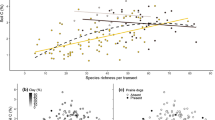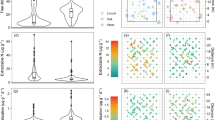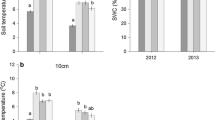Abstract
Arctic plant communities vary greatly over short distances due to heterogeneities in topography and hydrological conditions across the landscape. Recent evidence suggests substantial changes in vegetation including increasing shrub cover and density in the Arctic over the past three decades that may be in response to climate change. We investigated soil microbial biomass, nutrient availability, nitrogen (N) mineralization potential and nitrification potential in four of the principal vegetation-types across the low Arctic: dry heath, birch hummock, tall birch and wet sedge. Soil total carbon (C) and N contents, microbial biomass C, dissolved organic C (DOC) and N (DON), mineral N, and N mineralization potential differed considerably among vegetation-types. Tall birch and wet sedge soils had significantly higher DON, mineral N, and N mineralization potential than birch hummock or dry heath soils. Soil N mineralization potential across all soils was positively correlated with soil available C and N, and negatively correlated with soil total C:N ratios. Nitrification potential was negligible in all soils. These results demonstrate close relationships between soil biogeochemical properties, mineral N supply rates, and vegetation-types across an arctic landscape. Our soil N mineralization data suggest that climate warming may enhance N availability in tall birch soils more than in birch hummock soils, and therefore that increases in shrub densities across the landscape are most likely within and directly around current tall shrub patches.


Similar content being viewed by others
References
ACIA (2005) Arctic climate impact assessment. Cambridge University Press, Cambridge, p 1042
Biasi C, Wanek W, Rusalimova O, Kaiser C, Meyer H, Barsukov P, Richter A (2005) Microtopography and plant-cover controls on nitrogen dynamics in hummock tundra ecosystems in Siberia. Arctic Antarct Alpine Res 37:435–443
Billings WD, Luken JO, Mortensen DA, Peterson KM (1982) Arctic tundra—a source or sink for atmospheric carbon-dioxide in a changing environment. Oecologia 53:7–11
Bjork RG, Klemedtsson L, Molau U, Harndorf J, Odman A, Giesler R (2007) Linkages between N turnover and plant community structure in a tundra landscape. Plant Soil 294:247–261
Bret-Harte MS, Garcia EA, Sacre VM, Whorley JR, Wagner JL, Lippert SC, Chapin FS (2004) Plant and soil responses to neighbour removal and fertilization in Alaskan tussock tundra. J Ecol 92:635–647
Brookes PC, Powlson DS, Jenkinson DS (1982) Measurement of microbial biomass phosphorus in soil. Soil Biol Biochem 14:319–329
Brookes PC, Landman A, Pruden G, Jenkinson DS (1985) Chloroform fumigation and the release of soil-nitrogen—a rapid direct extraction method to measure microbial biomass nitrogen in soil. Soil Biol Biochem 17:837–842
Buckeridge KM, Grogan P (2008) Deepened snow alters soil microbial nutrient limitations in arctic birch hummock tundra. Appl Soil Ecol 39:210–222
Buckeridge KM, Zufelt E, Chu H, Grogan P (2009) Soil nitrogen cycling rates in low arctic shrub tundra are enhanced by litter feedbacks. Plant Soil (in review)
Chapin FS III, Shaver GR (1996) Physiological and growth responses of arctic plants to a field experiment simulating climatic change. Ecology 77:822–840
Chapin FS III, Shaver GR, Giblin AE, Nadelhoffer KJ, Laundre JA (1995) Responses of Arctic tundra to experimental and observed changes in climate. Ecology 76:694–711
Chapin FS, Sturm M, Serreze MC, McFadden JP, Key JR, Lloyd AH, McGuire AD, Rupp TS, Lynch AH, Schimel JP, Beringer J, Chapman WL, Epstein HE, Euskirchen ES, Hinzman LD, Jia G, Ping CL, Tape KD, Thompson CDC, Walker DA, Welker JM (2005) Role of land-surface changes in Arctic summer warming. Science 310:657–660
Cheng WX, Virginia RA (1993) Measurement of microbial biomass in arctic tundra soils using fumigation extraction and substrate-induced respiration procedures. Soil Biol Biochem 25:135–141
Cheng WX, Virginia RA, Oberbauer SF, Gillespie CT, Reynolds JF, Tenhunen JD (1998) Soil nitrogen, microbial biomass, and respiration along an arctic toposequence. Soil Sci Soc Am J 62:654–662
Christensen TR, Jonasson S, Callaghan TV, Havstrom M (1999) On the potential CO2 release from tundra soils in a changing climate. Appl Soil Ecol 11:127–134
Cleveland CC, Liptzin D (2007) C: N: P stoichiometry in soil: is there a “Redfield ratio” for the microbial biomass? Biogeochemistry 85:235–252
Davidson EA, Trumbore SE, Amundson R (2000) Biogeochemistry—soil warming and organic carbon content. Nature 408:789–790
Devi N, Hagedorn F, Moiseev P, Bugmann H, Shiyatov S, Mazepa V, Rigling A (2008) Expanding forests and changing growth forms of Siberian larch at the Polar Urals treeline during the 20th century. Glob Change Biol 14:1581–1591
Dredge L, Kerr D, Wolfe S (1999) Surficial materials and related ground ice conditions, Slave Province, NWT, Canada. Can J Earth Sci 36:1227–1238
Giblin AE, Nadelhoffer KJ, Shaver GR, Laundre JA, McKerrow AJ (1991) Biogeochemical diversity along a riverside Toposequence in Arctic Alaska. Ecol Monogr 61:415–435
Goetz SJ, Bunn AG, Fiske GJ, Houghton RA (2005) Satellite-observed photosynthetic trends across boreal North America associated with climate and fire disturbance. Proc Natl Acad Sci U S A 102:13521–13525
Grogan P, Jonasson S (2006) Ecosystem CO2 production during winter in a Swedish subarctic region: the relative importance of climate and vegetation type. Glob Change Biol 12:1479–1495
Gundersen P, Emmett BA, Kjonaas OJ, Koopmans CJ, Tietema A (1998) Impact of nitrogen deposition on nitrogen cycling in forests: a synthesis of NITREX data. For Ecol Manag 101:37–55
Hobbie SE (1996) Temperature and plant species control over litter decomposition in Alaskan tundra. Ecol Monogr 66:503–522
Hobbie SE, Schimel JP, Trumbore SE, Randerson JR (2000) Controls over carbon storage and turnover in high-latitude soils. Glob Change Biol 6:196–210
Hurlbert SH (1984) Pseudoreplication and the design of ecological field experiments. Ecol Monogr 54:187–211
IPCC (2007) Climate Change 2007. Intergovernmental Panel on Climate Change, Geneva, Switzerland
Johnson LC, Shaver GR, Cades DH, Rastetter E, Nadelhoffer K, Giblin A, Laundre J, Stanley A (2000) Plant carbon-nutrient interactions control CO2 exchange in Alaskan wet sedge tundra ecosystems. Ecology 81:453–469
Jonasson S, Michelsen A, Schmidt IK, Nielsen EB, Callaghan TV (1996) Microbial biomass C, N and P in two arctic soils and responses to addition of NPK fertilizer and sugar: implications for plant nutrient uptake. Oecologia 106:507–515
Jonasson S, Michelsen A, Schmidt IK (1999) Coupling of nutrient cycling and carbon dynamics in the Arctic, integration of soil microbial and plant processes. Appl Soil Ecol 11:135–146
Kirschbaum MUF (2000) Will changes in soil organic carbon act as a positive or negative feedback on global warming? Biogeochemistry 48:21–51
Lafleur PM, Humphreys ER (2008) Spring warming and carbon dioxide exchange over low Arctic tundra in central Canada. Glob Change Biol 14:740–756
Leadley PW, Reynolds JF (1992) Long-term response of an Arctic Sedge to climate change—a simulation study. Ecol Appl 2:323–340
McKane RB, Rastetter EB, Shaver GR, Nadelhoffer KJ, Giblin AE, Laundre JA, Chapin FS (1997) Climatic effects on tundra carbon storage inferred from experimental data and a model. Ecology 78:1170–1187
Nadelhoffer KJ, Giblin AE, Shaver GR, Laundre JA (1991) Effects of temperature and substrate quality on element mineralization in 6 Arctic soils. Ecology 72:242–253
Nadelhoffer KJ, Giblin AE, Shaver GR, Linkins AE (1992) Microbial processes and plant nutrient availability in arctic soils. In: Chapin FS III, Jefferies RL, Reynolds JF, Shaver GR, Svoboda J (eds) Arctic ecosystems in a changing climate: an ecophysiological perspective. Academic, San Diego, pp 281–300
Neff JC, Hooper DU (2002) Vegetation and climate controls on potential CO2, DOC and DON production in northern latitude soils. Glob Change Biol 8:872–884
Nobrega S, Grogan P (2008) Landscape and ecosystem-level controls on net carbon dioxide exchange along a natural moisture gradient in Canadian low arctic tundra. Ecosystems 11:377–396
Oechel WC, Vourlitis GL (1994) The effects of climate-change on land atmosphere feedbacks in Arctic tundra regions. Trends Ecol Evol 9:324–329
Ollinger SV, Smith ML, Martin ME, Hallett RA, Goodale CL, Aber JD (2002) Regional variation in foliar chemistry and N cycling among forests of diverse history and composition. Ecology 83:339–355
Paul EA, Clark FE (1996) Soil Microbiology and Biochemistry. Academic, San Diego, p 340
Ping CL, Michaelson GJ, Jorgenson MT, Kimble JM, Epstein H, Romanovsky VE, Walker DA (2008) High stocks of soil organic carbon in the North American Arctic region. Nature Geoscience 1:615–619
Porsild AE, Cody WJ (1980) Vascular plants of continental Northwest Territories, Canada. National Museums of Canada, Ottawa, p 667
Rampton VN (2000) Large-scale effects of subglacial meltwater flow in the southern Slave Province, Northwest Territories, Canada. Can J Earth Sci 37:81–93
Schmidt IK, Jonasson S, Shaver GR, Michelsen A, Nordin A (2002) Mineralization and distribution of nutrients in plants and microbes in four arctic ecosystems: responses to warming. Plant Soil 242:93–106
Serreze MC, Walsh JE, Chapin FS, Osterkamp T, Dyurgerov M, Romanovsky V, Oechel WC, Morison J, Zhang T, Barry RG (2000) Observational evidence of recent change in the northern high-latitude environment. Clim Change 46:159–207
Shaver GR, Chapin FS (1991) Production—biomass relationships and element cycling in contrasting Arctic vegetation types. Ecol Monogr 61:1–31
Shaver GR, Billings WD, Chapin FS III, Giblin AE, Nadelhoffer KJ, Oechel WC, Rastetter EB (1992) Global change and the carbon balance of Arctic ecosystems. Bioscience 42:433–441
Shaver GR, Giblin AE, Nadelhoffer KJ, Rastetter EB (1997) Plant functional types and ecosystem change in arctic tundras. In: Smith T, Shugart HH, Woodward FI (eds) Plant functional types. Cambridge University Press, Cambridge
Shaver GR, Johnson LC, Cades DH, Murray G, Laundre JA, Rastetter EB, Nadelhoffer KJ, Giblin AE (1998) Biomass and CO2 flux in wet sedge tundras: Responses to nutrients, temperature, and light. Ecol Monogr 68:75–97
Shaver GR, Canadell J, Chapin FS, Gurevitch J, Harte J, Henry G, Ineson P, Jonasson S, Melillo J, Pitelka L, Rustad L (2000) Global warming and terrestrial ecosystems: a conceptual framework for analysis. Bioscience 50:871–882
Sturm M, Racine C, Tape K (2001) Climate change—increasing shrub abundance in the Arctic. Nature 411:546–547
Tape K, Sturm M, Racine C (2006) The evidence for shrub expansion in Northern Alaska and the Pan-Arctic. Glob Change Biol 12:686–702
Walker DA (2000) Hierarchical subdivision of Arctic tundra based on vegetation response to climate, parent material and topography. Glob Change Biol 6:19–34
Acknowledgements
We thank Linda Cameron for laboratory assistance and technical support, Mat Vankoughnett and Meghan Laidlaw for field assistance, Kate Buckeridge for useful discussion, and Steve Matthews for logistics. We also appreciate the critical comments from two anonymous reviewers. This work was supported by NSERC through the International Polar Year Project: Climate change Impacts on Canadian Arctic Tundra.
Author information
Authors and Affiliations
Corresponding author
Additional information
Responsible Editor: Wim van der Putten.
Rights and permissions
About this article
Cite this article
Chu, H., Grogan, P. Soil microbial biomass, nutrient availability and nitrogen mineralization potential among vegetation-types in a low arctic tundra landscape. Plant Soil 329, 411–420 (2010). https://doi.org/10.1007/s11104-009-0167-y
Received:
Accepted:
Published:
Issue Date:
DOI: https://doi.org/10.1007/s11104-009-0167-y




